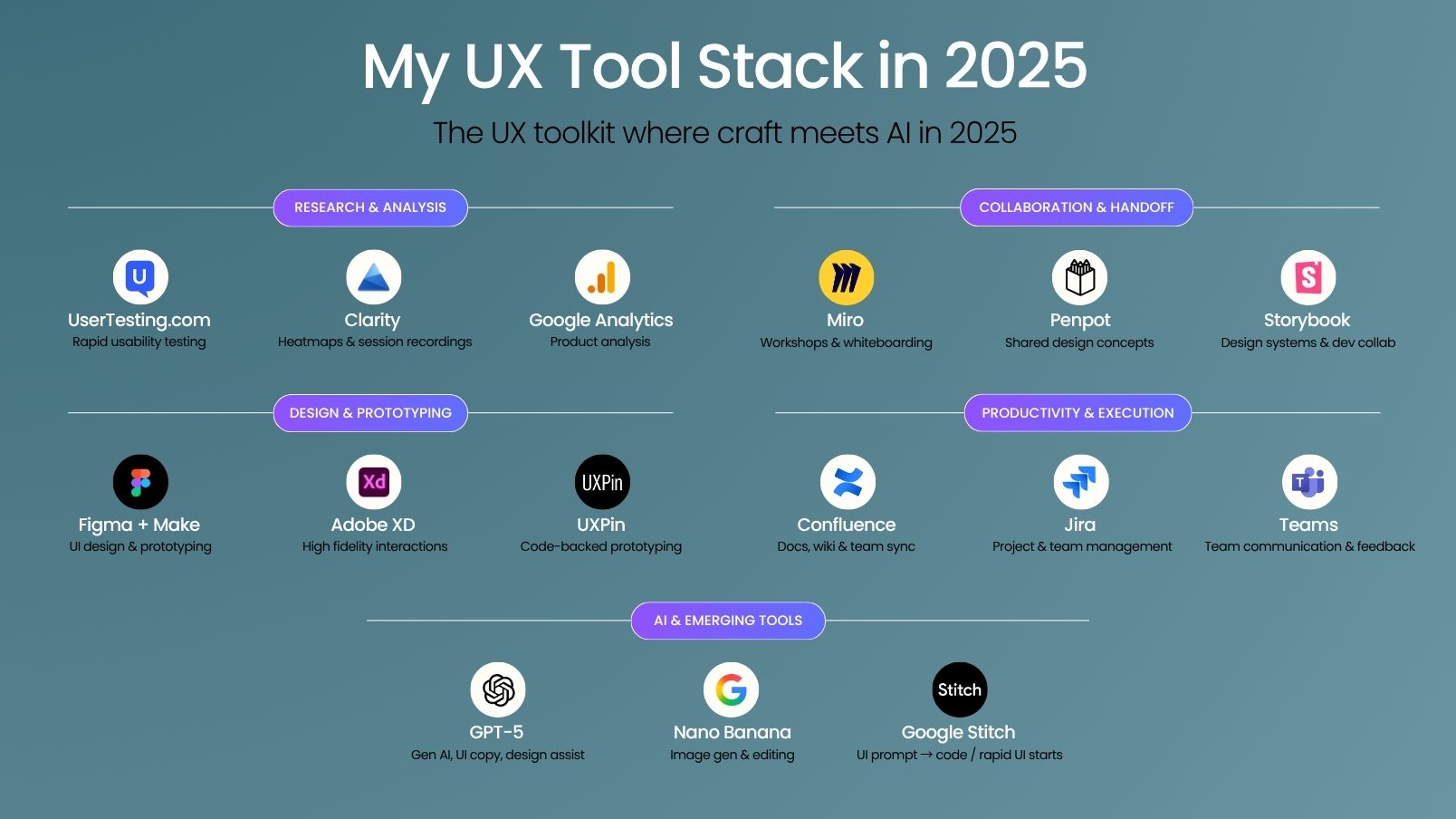The Strategic Design Process in the AI Era
Product design today has evolved into orchestrating people, systems, and generative intelligence. The job has shifted from grinding out deliverables to shaping flow and alignment alongside AI. The modern tool stack makes that shift a reality.

Deep Research & AI-Assisted Synthesis
The manual labor of synthesis (the hand-creation of assets) is obsolete. Today, AI tools ingest raw qualitative and quantitative data, immediately identifying patterns, tagging themes, and even generating preliminary affinity maps. This frees the senior designer to focus purely on strategic interpretation: framing the problem and identifying leverage points.
The AI-Powered Research Loop
The manual labor of synthesis is obsolete. Today, AI tools ingest raw qualitative and quantitative data, immediately identifying patterns, tagging themes, and even generating preliminary affinity maps. This frees the senior designer to focus purely on strategic interpretation: framing the problem and identifying leverage points.
UserTesting.com & Rapid Validation
AI now transcribes and auto-summarizes global usability testing sessions, condensing hours of footage into categorized pain points (e.g., 'Navigation Friction,' 'Cognitive Load'). This enables theme generation in hours, not weeks.
Microsoft Clarity & Friction Tagging
Behavioral analytics tools use ML to auto-tag session recordings with "friction events" and "rage clicks." We no longer hunt for bad sessions; the system flags why users churned and provides immediate context.
Design Velocity: From Prompt to Code-Backed Prototype
The key performance indicator in 2025 is time-to-first-build. Tools like Figma, augmented with generative AI, convert high-level conceptual prompts into fully-fledged, auto-layout-ready component structures in minutes. The value of a senior designer is no longer their speed with the Pen Tool, but their mastery of the component library, their architectural vision, and their ability to prompt for system integrity.
The Prompt-Driven UI Generation
Designers now curate, not draw. The focus shifts to prompt engineering and system architecture.
Text Prompt (The Vision)
Strategic constraints and user requirements
Figma Make / Google Stitch
Auto-Generates responsive components & flows.
Designer Refinement (The Human Factor)
Focus on critical paths, edge cases, and accessibility.
Code-Backed Prototyping
Prototyping tools are no longer just visual mocks. They sync with production codebases (Storybook), allowing immediate, high-fidelity testing and bypassing the 'design vs. code' parity problem entirely. The prototype is the spec.
"The Best UI is No UI"
Sometimes, the best design decision is to not design anything new at all. Strategic use of existing components, or leveraging a simple native solution, is the mark of an efficient, system-aware designer. We design out complexity.
System Architecture First
Senior value comes from understanding component relationships, state management, and design system implications, not pixel-perfect execution.
From Handoff to Co-Creation: The Integrated Team
Real-Time, Seamless Alignment
The concept of a "handoff" is an anachronism. Modern product teams operate in a continuous co-creation model. The design system is the central artifact, and documentation is living, not static. This requires tools that break down proprietary silos and promote a shared component language.
Miro & AI-Augmented Workshops
Workshops are distributed and asynchronous. Miro's AI clustering feature instantly organizes sticky notes, ideas, and flows, eliminating the need for hours of post-workshop manual sorting. The human time is spent debating strategy, not synthesizing inputs.
Storybook: The Unified Source of Truth
Storybook is essential. It is the living documentation where components are testable, documented, and visually verifiable in code. When designs change in Figma, the corresponding component status in Storybook updates, ensuring developers are always building against the latest, vetted asset.
Shared Component Model
Design System = Code = Documentation
Governing Velocity: Project Management and Political Acumen
AI as Project Manager
Execution is increasingly automated. AI agents monitor Figma comments, cross-reference them with Storybook, and auto-generate Jira tickets containing detailed Acceptance Criteria (AC). This eliminates manual spec-writing and ensures traceability from idea to deployment.
Jira & Automated AC Generation
The system links design elements directly to tickets. If a text field's character limit is specified in a prototype, the AI uses this context to automatically populate the AC in the Jira ticket, reducing human error and time.
Confluence: Living Knowledge Base
Confluence is no longer a document graveyard. AI actively curates and summarizes team knowledge, linking design decisions to initial research outcomes and business KPIs, making it a truly 'living' repository.
The Future State: AI as Strategic Co-Pilot
The role of the product designer has shifted. We’re not just executors. We’re curators and strategists. Our value isn’t in how fast we can move pixels, but in the quality of our input: sharp prompts, clear constraints, and the human eye that decides what feels right. Taste matters. Knowing what’s cool, what resonates, what sells. The tools can generate endless options, but it’s our ability to curate, refine, and guide that gives the work its value and keeps it human.
Tools That Define the Next Decade
UI from Text-to-Code
Tools like Figma Make and Google Stitch are the future of prototyping, turning structured design prompts into production-ready UI components (React/Angular/Vue). They enable us to move from ideation to a fully functional A/B test in days, not weeks, by bypassing manual front-end development for common UI patterns.
Contextual Assets
Image gen tools like Google's Nano Banana, Adobe Firefly, and Midjourney provide lightning-fast image generation for high-fidelity mockups, allowing designers to create unique, context-specific imagery (e.g., placeholder user avatars, product illustrations) that perfectly matches the product's visual system, eliminating dependency on stock photo sites.
AI-Generated UI Copy
AI tools now draft and localize interface text, from button labels and onboarding flows to error messages and microcopy. They generate multiple tone options, provide translations, and even align wording with brand guidelines. Designers become curators of language, ensuring clarity, consistency, and the right human touch across every screen.
The Designer's Core Value
Refinement & Empathy: The Human Element that AI Cannot Replace
Conclusion: The New Mandate
The 2025 process is defined by the AI Multiplier. Our time is now spent auditing, validating, and directing generative output, not creating from a blank canvas. Seniority is measured by strategic refinement: knowing when to accelerate with AI and when to slow down for critical human-centered decisions.
Product design is still about people; AI is simply our fastest, most efficient co-pilot in serving them.
